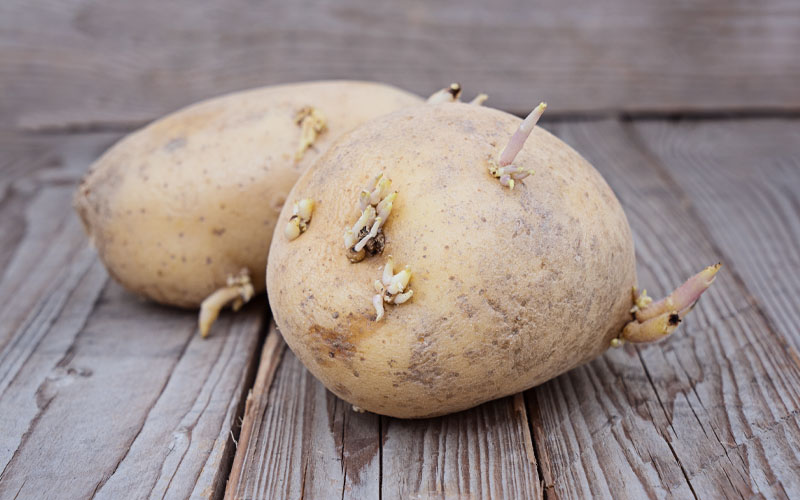Whether you’re having dinner at your nearby restaurant, pulling up at your favorite fast food’s drive-through, or enjoying snacks with tea, you ‘ll see potatoes everywhere — baked, mashed, boiled, French fries, hash brown, or any form.
Rich in carbohydrates and low in fats, potatoes are one of the most accessible sources of energy today.
But like every other food item, be it fruit or vegetable, it tends to go bad.
And this is what is blog is all about.
So let’s give it a go.
Table of Contents
How to Tell If potatoes Have Gone Bad?

It’s pretty common that you bought potatoes and kept it in your pantry for some time, and the moment you were ready to use it, you realized they’re not fit at all. Means, they have gone bad. So, how to tell if the potatoes have gone bad or not?
The following signs may help you identify the potatoes that are not fit for use or buying at the first instant.
- GREEN SPOTS. It’s usually the first sign that potatoes are going bad. It indicates the presence of a toxin due to the increase of a chemical substance, Solaline, in it.

- MOLD. Moldy spots on the potatoes are more severe conditions than green spots. It’s due to the bruises they get during harvesting or transportation time and is called fusarium. Such potatoes should not be eaten, instead should be discarded so that the healthy ones along with these can be protected

- SPROUTING. Sprouts are kind of roots that start to grow on potatoes. If you dump it in moist soil, it will grow into a plant. The process is called germination. But still, you can use that potato by peeling off that sprout.

DO YOU KNOW?
One of the leading causes of the Great Famine in Ireland between 1845 and 1852 was a potato disease known as Potato Blight. This shortage of potatoes led to the death of around 1 million people who were dependent on them as a food source.
Shelf Life of Potatoes
Whether you run a vegetable shop or are simply a housewife, you want to keep the potatoes good for as long as possible. But since the shelf life of potatoes isn’t that long, it needs a bit of care to have a long life.
Let’s look at how long do potatoes last on the counter before they go bad.
i. How Long Do Potatoes Last In The Freezer?

Because of their high water content, raw potatoes are not recommended for freezing. In this way, they discolor, and the taste becomes extremely bad when they are thawed before cooking.
When a raw potato is frozen, the molecular structure inside it breaks, making them mushy and unusable when thawed.
However, by cutting it in the slices and removing the natural water by any method, like half-frying, it can last for 6-8 months in the freezer.
Freezing mashed potatoes is easy. Make even portions of mashed potatoes and line them on a tray layered with baking sheet. Keep this in the freezer overnight. Now, pack these portions into a ziplog bag. Surprisingly, these mashed potatoes will last for two months.
ii. How Long Do Potatoes Last In The Refrigerator/Fridge?

It’s quite usual that you got a load of vegetables from the grocery store and want to keep them fresh for long and dump into your refrigerator.
It’s usual; it’s beneficial. But in some cases, it’s not a good idea as with potatoes.
Refrigerating potatoes spoil the taste. The cold temperature turns the starch of potatoes into sugar quicker than at normal temperature and therefore tastes bad when cooked.
On the other hand, refrigerating potatoes pose another danger. Keeping potatoes in the fridge convert its starch into sugar. And when it’s exposed to high temperatures while frying or baking, the amino acid inside it reacts with sugar, resulting in the formation of a harmful chemical called Acrylamide.
Research studies have classified Acrylamide among carcinogens (cancer-causing).
Subject to the caution mentioned above, raw potatoes, of whatever type like White, Red, Yukon Gold, or Sweet potatoes can last for 2-3 weeks in the fridge.
On the other hand, shredded potatoes or French-fried potatoes can last for 1-2 days in the refrigerator only.
A cooked and baked potato can last up to 5-7 days in the fridge, whereas mashed potatoes can last up to 3-4 days only.
iii. How Long Do Potatoes Last In The Pantry/Room Temperature?

Probably you may be wondering how long do potatoes, both cooked and uncooked, last if unrefrigerated. Well, most of the storage happens like this. If the room temperature is not as high as in the extreme summer season, potatoes can be best saved in the pantry.
Whatever type of potatoes you have, like White, Red, Sweet, or Yukon Gold, they can survive for 2-3 months if the temperature is slightly warmer than in fridge and cooler than normal room temperature, that is approx. 50-60°F – ideal for storage.
Quite interestedly, sliced, cooked, or mashed potatoes cannot last in the room temperature for more than a few hours if it’s hot outside.
Here, a question may pinch you as to how long does a potato salad last? Well, in a potato salad recipe, it’s not potato alone, but mayonnaise, egg, vinegar, onion, mustard, and other ingredients are added as well. So, being a mixture, it can last up to 2-3 hours at the room temperature, or 3-5 days if kept in the fridge.
Best Ways to Store Potatoes For a Long Time
i. Place in Slightly Cool Place

A study concluded that storing potatoes in slightly cold temperatures increases its shelf life more than four times.
Means, the temperature which is slightly warmer than refrigerator’s but cooler than the room temperature. Because at room temperature, sprouts start to form, the first sign of spoilage. An ideal temperature is between 6-10 °C.
According to a research, the phenolic content and antioxidant activity of potatoes remain higher in cold storage at mild temperatures, even higher than at the harvest time.
ii. Keep Them in Low Indirect Light

One of the traditional methods followed to store potatoes was to store it in dark light. Storing in the dark prevents them from turning green, but it causes excessive sprouting, especially in the warmer, low land, and coastal areas.
A modern method developed by the International Potato Center, Peru, was the Diffused Light (indirect) with proper ventilation. Under this method, potatoes are placed in thin layers where indirect light and air can reach easily.
So, if next time you purchase more potatoes and want to save it for days to come, keep it in an airy container in your pantry where the temperature is neither too high nor too low, that too with least humidity. Because without proper ventilation, the moisture released by them will let bacteria grow.
iii. Don’t Wash Unless You’re Ready to Use it

One of the mistakes moms usually do is to wash the potatoes the moment they reach our pantry because they look quite muddy. That’s a wrong practice, even though washing removes most of the pesticide residue in vegetables.
Instead of taking it close to water, it’s better to clean it with some dry cloth. Otherwise, water will cause fungus to grow pretty soon after storing it.
iv. Keep it Separated from Other Food

Do you remember your mum asking you not to place apples in the refrigerators? Why? Because apples release ethylene gas that mixes with other dishes and develops a strange taste in them.
Similarly, while storing potatoes, it’s better not to place them near onions, and fruits like apples or sprout will start to form.
In other words, it’s not advisable to store it near fruits and vegetables that ripe.
Nutrient Facts of Potatoes
Following is a bird’s eye view of the nutrient present in Potatoes
| One Medium-Sized potato: 2.5-inch diameter (213g) | |
| Total Calories = 163 | |
| Energy = 686 kj | |
| Calcium | 25.6mg |
| Carbohydrate | 37.3g |
| Cholesterol | 0 |
| Fats | 0.192g |
| Fiber | 4.47g |
| Magnesium | 49mg |
| Phosphorus | 121mg |
| Potassium | 890mg |
| Protein | 4.37g |
| Sodium | 12.8mg |
| Starch | 32.6g |
| Sugar | 1.75g |
| Vitamin B-6 | 0.635mg |
| Vitamin C | 42mg |
Nutrients Lost in Storage, Cooking and Processing Potatoes
i. Does Storage Affect the Nutrient Value of Potatoes?

The highest amount of nutrients is found in freshly harvested potatoes that are cooked without removing its peel.
Storage tends to increase the concentration of Pyridoxine. If you are preparing it domestically in your kitchen, the stored potatoes should ideally be boiled or steamed to ensure it retains the maximum amount of Vitamins.
Storage makes potatoes lose 50% of their ascorbic acid (the vitamin C), while no change in Nitrogen level has been noticed.
ii. How Does Cooking Affect the Nutrient Value of Potatoes?

The nutrient loss depends upon the cooking method one follows.
Nutrients lost in French fries, and baked potatoes are the least; and, are equivalent to boiled potatoes without peeling off the skin.
iii. How Processing Affects Potatoes’ Nutrient Value?

Processing does affect the vitamins in potatoes, but it does not mean processing makes it lose all its nutrients.
For example, raw and boiled potatoes have much more nutrients than a similar amount processed in the form of flakes. So, manufacturers need to add additional immune system boosters, like vitamin C.
Processed potato products have a higher amount of sodium, acrylamides, and fats.
Conclusion:
Like any other vegetable, potatoes do have a shelf life. Multiple factors determine which storage method is appropriate. But one thing is for sure, keeping potatoes in the fridge or freezer in the raw form without any processing or curing is not healthy.

